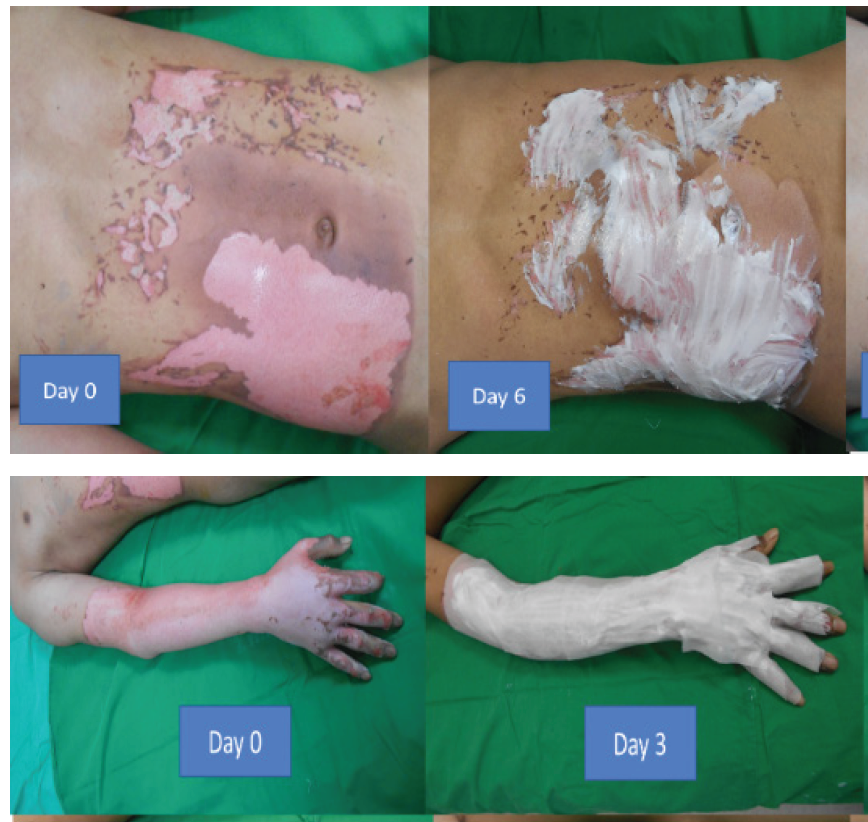Clinical Efficacy Test of Polyester Dressing Containing Herbal Extracts and Silver Sulfadiazine Cream Compared with Silver Sulfadiazine Cream in Healing Burn Wounds: A Prospective Randomized Controlled Trial
DOI:
https://doi.org/10.33192/Smj.2021.97Keywords:
Burn, wound, silver sulfadiazine cream, hydrocolloids dressingAbstract
The standard burn wound treatment is the application of silver zinc sulfadiazine cream, covered with sterilized gauze dressing. This method has been used for decades because of its reasonable costs and applicability for larger wound sizes. However, gauze with a large pore size may stick to the wound bed and cause wound trauma, leading to delayed healing. The patient may also experience additional pain during changing the dressing. The non-adherent property of a hydrocolloid dressing coated with herbal extract (SIHERB) can promote wound healing as well as reduce pain.
This study compared the two methods of burn wound treatment in the same patients, who were split into a “treatment group”, who were applied both silver sulfadiazine cream and hydrocolloid dressing, and “control group”, who were applied only silver sulfadiazine cream. The studied outcomes were the number of days for wound closure, the percentage epithelialization, and the pain score (evaluated every three days until epithelialization was completed). In total, 24 patients at the Burn Clinic, Siriraj Hospital were enrolled on this study. The starting wound areas were ranged from 210–220 cm2. The treatment group exhibited significant results regarding faster wound healing, referring to the number of days taken for wound closure (18 days in the control group vs. 15 days in the experimental group) and the percentage epithelialization compared to the control group. The average pain score in the experimental group was also lower on days 9, 12, and 15 after treatment (p < 0.05). No adverse effects were observed during the study.
In conclusion, the combination of hydrocolloid dressing and silver sulfadiazine cream could reduce the wound shearing force and wound bed injury, accelerating the rate of wound closure and decreasing the pain during changing the dressing. This technique could improve upon the standard burn wound treatment.
References
2. Sanchez JL, Pereperez SB, Bastida JL, Martinez MM. Cost-utility analysis applied to the treatment of burn patients in a specialized center. Arch Surg 2007; 142(1): 50-7; discussion 7.
3. Torrati FG, Rossi LA, Ferreira E, Dalri MC, de Carvalho EC, dos Santos Barbeira CB. Analysis of cost of dressings in the care of burn patients. Burns 2000; 26(3): 289-93.
4. Dyster-Aas J, Kildal M, Willebrand M. Return to work and health-related quality of life after burn injury. J Rehabil Med 2007; 39(1): 49-55.
5. Moncrief JA. Burns. N Engl J Med 1973; 288(9): 444-54.
6. Hoffmann S. Silver sulfadiazine: an antibacterial agent for topical use in burns. A review of the literature. Scand J Plast Reconstr Surg 1984; 18(1): 119-26.
7. Ma KK, Chan MF, Pang SM. The effectiveness of using a lipido-colloid dressing for patients with traumatic digital wounds. Clin Nurs Res 2006; 15(2): 119-34.
8. Khorasani G, Ahmadi A, Jalal Hosseinimehr S, Ahmadi A, Taheri A, Fathi H. The Effects of Aloe Vera Cream on Split-thickness Skin Graft Donor Site Management: A Randomized, Blinded, Placebo-controlled Study. Wounds 2011; 23(2): 44-8.
9. Shetty BS, Udupa SL, Udupa AL, Somayaji SN. Effect of Centella asiatica L (Umbelliferae) on normal and dexamethasone-suppressed wound healing in Wistar Albino rats. Int J Low Extrem Wounds 2006; 5(3): 137-43.
10. Shahzad MN, Ahmed N. Effectiveness of Aloe Vera gel compared with 1% silver sulphadiazine cream as burn wound dressing in second degree burns. J Pak Med Assoc 2013; 63(2): 225-30.
11. Saeidinia A, Keihanian F, Lashkari AP, et al. Partial-thickness burn wounds healing by topical treatment: A randomized controlled comparison between silver sulfadiazine and centiderm. Medicine (Baltimore) 2017; 96(9): e6168.
12. Muangman P, Praditsuktavorn B, Chinaroonchai K, Chuntrasakul C. Clinical Efficacy Test of Polyester Containing Herbal Extract Dressings in Burn Wound Healing. Int J Low Extrem Wounds 2016; 15(3): 203-12.
13. Chuntrasakul C, Muangman, P., Benjathanung, R., Suvanchote, S., Boonpamee, S., Jantarapakdee, S., & Kittidacha, S. Clinical Experience of ActicoatTM Treatment in Extensive Burn Wounds. Siriraj Medical Journal 2007; 59(2): 47-51.
14. Lohsiriwat V, Siripoon C, Kitmanee M, Vongviriyangkoon T. Laser Doppler Analysis of Blood Perfusion in Burn Wounds. Siriraj Medical Journal 2008; 62(1): 14-6.

Published
How to Cite
Issue
Section
License
Authors who publish with this journal agree to the following conditions:
Copyright Transfer
In submitting a manuscript, the authors acknowledge that the work will become the copyrighted property of Siriraj Medical Journal upon publication.
License
Articles are licensed under a Creative Commons Attribution-NonCommercial-NoDerivatives 4.0 International License (CC BY-NC-ND 4.0). This license allows for the sharing of the work for non-commercial purposes with proper attribution to the authors and the journal. However, it does not permit modifications or the creation of derivative works.
Sharing and Access
Authors are encouraged to share their article on their personal or institutional websites and through other non-commercial platforms. Doing so can increase readership and citations.














